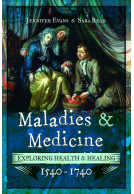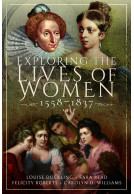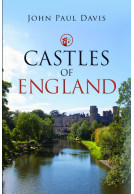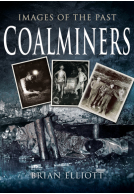Maladies and Medicine (ePub)
Exploring Health and Healing, 1540 - 1740
Imprint: Pen & Sword History
File Size: 5.9 MB (.epub)
Pages: 182
Illustrations: 30 illustrations
ISBN: 9781473875739
Published: 4th July 2017
Publicity!
- Watch author Jennifer Evans discussing aphrodisiacs with Tasha Marks in this YouTube video for The British Library.
- Watch this promotional video via YouTube featuring Jennifer Evans and Sara Read, filmed at Tamworth Castle in spring 2017.
- Inside Versailles: Jennifer Evans appeared on an episode of the BBC's Inside Versailles in May 2017, with presenters Professor Kate Williams and Greg Jenner.
- Article by authors as featured in The i Paper: Polio is on the brink of joining a long list of historical illnesses. Jennifer Evans and Sara Read reveal five other gruesome ailments that struck fear but are thankfully no longer with us.
- Sara Read on BBC West Midlands’ Sunday breakfast show with Llewela Bailey (29/10/17)
- Dr Read: “an expert on early modern literature and medicine” as featured in the Independent, ITV, Prima and The Scotsman
| Other formats available | Price |
|---|---|
| Maladies and Medicine Paperback Add to Basket | £15.99 |
Maladies and Medicine offers a lively exploration of health and medical cures in early modern England. The introduction sets out the background in which the body was understood, covering the theory of the four humours and the ways that male and female bodies were conceptualised. It also explains the hierarchy of healers from university trained physicians, to the itinerant women healers who travelled the country offering cures based on inherited knowledge of homemade remedies. It covers the print explosion of medical health guides, which began to appear in the sixteenth century from more academic medical text books to cheap almanacs.
The book has twenty chapters covering attitudes towards, and explanations of some of, the most common diseases and medical conditions in the period and the ways people understood them, along with the steps people took to get better. It explores the body from head to toe, from migraines to gout. It was an era when tooth cavities were thought to be caused by tiny worms and smallpox by an inflammation of the blood, and cures ranged from herbal potions, cooling cordials, blistering the skin, and of course letting blood.
Case studies and personal anecdotes taken from doctors notes, personal journals, diaries, letters and even court records show the reactions of individuals to their illnesses and treatments, bringing the reader into close proximity with people who lived around 400 years ago. This fascinating and richly illustrated study will appeal to anyone curious about the history of the body and the way our ancestors lived.
Maladies and Medicine is an always informative, often fascinating, at times wince-inducing look at the various illnesses diagnosed in in the early-modern period, as well as their various treatments, although both “illnesses” and “treatments” can be misleading terms, given that not all such sicknesses were actual ailments and that the vast majority of treatments not only didn’t do much for the sufferer but may have (in the case of mercury treatments for instance) made things far worse.
NetGalley, Bill Capossere
From start to finish, what Evans and Read have given us in Maladies and Medicine is an opportunity to reflect on our collective achievements in the realm of healthcare: knowing the history of medicine helps us appreciate the modes of healing we have right now, and it makes us optimistic, yet critical, of its future. In a way, Maladies and Medicine is a highly-readable and lucid time-machine that takes us back to when medicine was in transition, on the way to a brighter modernity. By taking the trip in its pages, we can investigate the past to better inform and shape the future of medicine. The good thing is, time-travelling with books is much safer: there’s little to no risk of having your head drilled when headaches arise.
Scalpen Blog
But we can’t avoid accidents. Good thing we have a medical text in our hands to tell us what to do when the unfortunate happens.
Read the full review here
Author article 'Snuffs and sneezes cure diseases' as featured by
History Today, January 2019
This volume provides a broad overview to health and healing in the early modern period, thus spanning from the early days of Henry VIII up to the early Georgians. One of the strengths of this book is its concentration on the types of illness suffered and the medical cures that might be offered.
Family & Community Historical Research Society
This book will be of use to the amateur who simply dips into historical research for interest through to the professional and academic historian. For those setting out to explore the history of medicine the clear and concise way which this volume is written means that it will lay a sound foundation of knowledge. For others this book will become a useful point of reference and returned to on a regular basis.
Lil's Vintage World, YouTube Blog
Evans and Read describe the contemporary English understanding of the aetiology and treatment of each of the ailments. They have read widely and complement the text with well-chosen excerpts from medical texts, diaries written by patients and doctors, and advertisements for cures promoted
British Society for the History of Medicine
by entrepreneurs. A few familiar images illustrate the work.
Grounded in real scholarship, Maladies and Medicine is nevertheless easy to read. As an excellent example of Roy Porter’s “bottom up” medical history for the non-specialist, this book will inform,
educate and amuse.
Maladies & Medicine is engrossing. The authors more than fulfill their stated aim of providing insight into what it meant to be alive, thrive and survive in the era.
WDYTYA? October, 2017 – reviewed by Elizabeth Norton
Author interview and book review
Your Family History magazine, September 2017
Provides a fascinating and useful insight into how people perceived and attempted to treat disease in that era.
Read it for: An excellent primer in early modern medicine.
As featured in
Yorkshire Post
My bedtime read at the moment is the Poldark series, set in the late 18th century, and one of the principal characters is the young doctor, Dwight Enys. Some of the practices used by his older colleagues in the same profession would make your stomach churn, and those same practices are adequately described in this superb teatise on medical treatments and ailments by authors Sarah Read and Jennifer Evans. This is an essential piece of social history that may literally have you in stitches - if you haven't yet discovered the new BBC comedy Quacks, now is the time... and this is a wonderful book to fill you in on all those arcane practices as we started to develop modern methods of medical practice. Absolutely fascinating!
Books Monthly
While being quite gross (in fact, I highly suggest that this not be read while snacking), Read describes a full spectrum of symptoms and conditions caused by a disruption of humours, bile, blood, and phlegm; for example, purges to treat epilepsy help to sweat out fit-causing slime, phlegm crowding around nerves releasing 'animal spirits,' toothaches being caused by suppressed worms inside of teeth, the heat of someone's body baking stones in their kidneys, the discovery of Jesuit's powder or quinine, the difference between ulcers (tumors) and cankers (subdermal scabs), the influx of gout coinciding with the availability of port and fortified wine from Portugal, indicators and quarantine rules for the plague, and peeing on plants to gauge one's fertility.
GoodReads, Kristine Fisher
As featured in
I News
Rating: 4 out of 5 stars
NetGalley, reviewed by Kristine Fisher
This head-to-toe guide to early modern medicine provides readers with an overview of the maladies and treatments people faced. It is clear that one's social class influenced one's chances of survival in many cases, but some diseases struck indiscriminately (even Elizabeth I was afflicted with smallpox). Of course, some treatments were so gruesome that perhaps it was better to hope for a quick death instead. Read and Evans also explain how the health landscape has shifted over the centuries; for example, during one week in 1665 (a plague season, no less) cancer and drowning accounted for two deaths each, but were outnumbered by over 350 deaths from gastrointestinal issues. Improved hygiene has limited our encounters with fleas, mites, and worms, while global trading and varied diets have made scurvy rare in developed nations. Yet childbirth continues to threaten women's lives, even with the advanced medical interventions now available. This book is a comprehensive read for anyone interested in medicine, as well as those seeking to better understand the lives and deaths of people in the early modern period and how they handled everything from mild ailments to terminal illnesses.
Brooke Weber, GoodReads
This was an endlessly interesting book! I actually found myself pacing my reading so that I didn't just speed through it. Each chapter is divided up into a different illness, where we are given a great overview peppered with content from primary sources. This was a time period / subject that I didn't know too much about going in, and by the end I was sharing things I'd learned with my partner and people at work haha!
NetGalley, reviewed by Alison Gilchrist
I don't think I have any criticisms, aside from wishing it was longer since I enjoyed it so much! I would love to see the authors do a "Part 2" for all the illnesses and conditions that didn't make the cut into this book.
This is a straight-up history book. While the authors certainly inject frivolity and humor into the book, this is meant more for the dedicated history buff, and not for the casual reader. Evans and Reed, while admitting to the books limitations in scope (it's a big topic), include a vast amount of information, conveniently divvied up by disease. The authors also delve into the differences between medical doctors, surgeons, midwives and other practicing women, and the unofficial medical practitioners. Each has their own origin and medical views, and it is curious to see when they agree, disagree, and borrow from one another.
NetGalley, reviewed by Katherine Mirobelli
History buffs will find a lot of great information (and a lot of cringe-worthy knowledge) in this book. If you're interested in medieval history or medical history, this book is a great addition to your TBR.
About Dr Jennifer Evans
Jennifer Evans is a senior lecturer in History at the University of Hertfordshire. Her academic research is focused on the body, medicine and gender and covers the period 1550-1750. To date her research has examined the understanding of infertility and its treatments in early modern England.
About Dr Sara Read
Dr Sara Read is a lecturer in English at Loughborough University. She holds a PhD in early modern literature. Her particular interest is in representations of the female body in literature and she has published widely in this field. Her first book Menstruation and the Female Body in Early Modern England was published by Palgrave Macmillan in 2013, and she has co-edited a collection of early modern women’s writings on the topic of health and spirituality called Flesh and Spirit: An Anthology of Seventeenth-century Women’s Writing for Manchester University Press, 2014. In addition, Dr Read has published a number of social history articles for Discover Your Ancestors magazine.


















